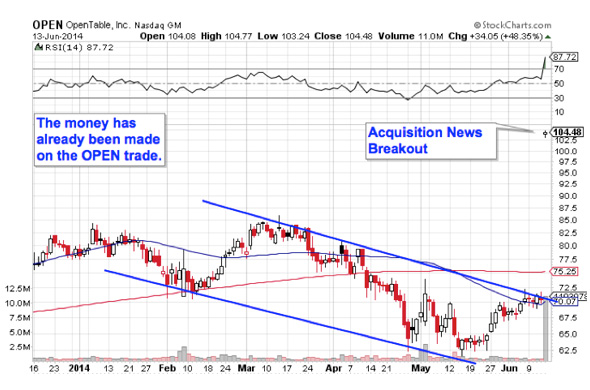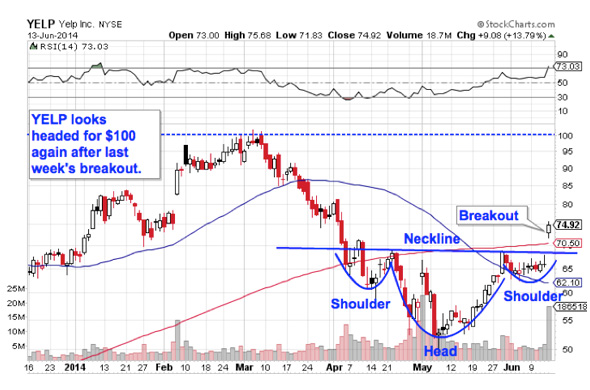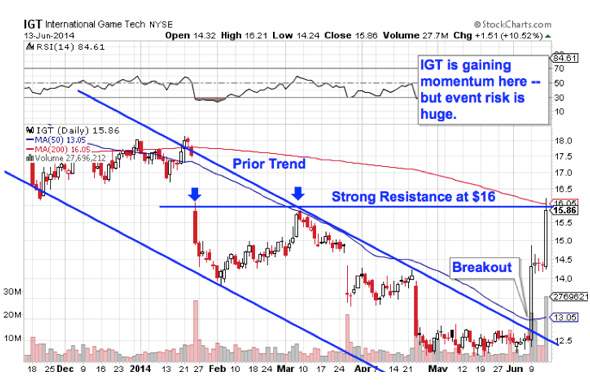Data traffic is expected to grow 23% annually over the next four years. Growing data creates complexity in managing and securing data. Data centers are moving towards the next-generation of virtualization and cloud environment. As a result, many networking companies are updating their products and technology to step up security and data management. Three such companies discussed in this post are developing various technologies to simplify data management and capitalize on the expanding market.
For the second quarter of fiscal 2014, F5 Networks, Inc. (FFIV) announced revenue of $420.0 million, up 3 percent from $406.5 million in the prior quarter and 20 percent from $350.2 million in the second quarter of fiscal 2013. Moreover, revenues were positively impacted by an 18.0% hike in Services revenues and a 21.6% increase in Product revenues on a year-over-year basis.
Application Delivery Controller, or ADC, segment accounts for the product revenue of the Company. Product revenue of $225.1 million grew 3% sequentially and 22% year-over-year, representing 54% of total revenue.. With improvisation in data centers, it announced an updated version of its chief ADC platform software, BIG-IP.
The updated version of BIG-IP, called BIG-IP v11.4, simplifies management of applications and data over physical networks, virtual networks, and cloud environment. This updated software will enhance its ADC segment. Furthermore, Cisco's exit from the ADC market will add to F5 Networks' market share growth opportunity. Its market share is expected to improve from 27.1% currently to 27.6% by the end of fiscal year 2015.
The increasing usage of 3G and 4G data from mobile devices is increasing the demand for content and applications. This situation is increasing network complexity and reducing security, increasing the probability of cyber attacks. The security products S/Gi firewall, offered by the company, is certain to benefit from this market of cyber security. This product protects the network service providers' infrastructure to ensure network availability and performance.
It will also protect subscribers from threat during data sharing. S/Gi will enhance connections per second by 20 times, which is equivalent to 8 million people using a service providers' network. This product will also contribute to F5 Networks' total revenue as the cyber security markets rises due to increased data traffic.
Data centers are becoming the foundation of every organization, and I.T. departments are moving towards cloud storage and virtualization. With organization adapting to various SAAS (Software As A Service) application deployed over cloud had created new market for data centers. To capitalize on this, Citrix Systems (CTXS): and Cisco recently expanded their strategic alliance to provide advanced technology in this market. The companies have been in partnership for the past two years.
Under this expanded alliance, Citrix will deliver its ADC technology 'NetScaler' to Cisco. NetScaler is a device that provides load balancing across multiple computer networks. In addition, this alliance recently released the next-generation of NetScaler called Netscaler10. NetScaler 10, its next-generation application delivery controller (ADC) that is the company's answer for bringing dynamic elasticity to the network. NetScaler 10 has automatic failure identification and management, which means that if there is a failure, NetScaler will identify it and automatically switch workloads to another ADC.
Cisco's technical support center will assist this new technology and will sell it through its various channel partners. As Cisco has already made an exit from the ADC market, this alliance will help the company serve its existing customers, without actually producing ADC products.
With this, Cisco will provide cloud network service to Citrix so it can develop a highly advanced cloud platform. The combination of the new NetScaler and the cloud service will strengthen Citrix's ADC market. The flexible licensing policy of the company enables the customers to easily opt for NetScalar. Pay-As-You-Grow pricing policy, provides investment protection, avoids costly hardware upgrades, and reduces TCO
The bottom line The companies are capitalizing on the opportunity provided by the shift in data management trends by updating their technologies and products. F5 Networks is enhancing its ADC segment with new security products for mobile threats. Citrix and Cisco are expanding their partnership to evolve the next generation ADC portfolio.
I would recommand a but for both these companies.
| Currently 0.00/512345 Rating: 0.0/5 (0 votes) | |

Subscribe via Email

Subscribe RSS Comments Please leave your comment:
More GuruFocus Links
| Latest Guru Picks | Value Strategies |
| Warren Buffett Portfolio | Ben Graham Net-Net |
| Real Time Picks | Buffett-Munger Screener |
| Aggregated Portfolio | Undervalued Predictable |
| ETFs, Options | Low P/S Companies |
| Insider Trends | 10-Year Financials |
| 52-Week Lows | Interactive Charts |
| Model Portfolios | DCF Calculator |
RSS Feed  | Monthly Newsletters |
| The All-In-One Screener | Portfolio Tracking Tool |

MORE GURUFOCUS LINKS
| Latest Guru Picks | Value Strategies |
| Warren Buffett Portfolio | Ben Graham Net-Net |
| Real Time Picks | Buffett-Munger Screener |
| Aggregated Portfolio | Undervalued Predictable |
| ETFs, Options | Low P/S Companies |
| Insider Trends | 10-Year Financials |
| 52-Week Lows | Interactive Charts |
| Model Portfolios | DCF Calculator |
RSS Feed  | Monthly Newsletters |
| The All-In-One Screener | Portfolio Tracking Tool |
FFIV STOCK PRICE CHART

111.11 (1y: +60%) $(function(){var seriesOptions=[],yAxisOptions=[],name='FFIV',display='';Highcharts.setOptions({global:{useUTC:true}});var d=new Date();$current_day=d.getDay();if($current_day==5||$current_day==0||$current_day==6){day=4;}else{day=7;} seriesOptions[0]={id:name,animation:false,color:'#4572A7',lineWidth:1,name:name.toUpperCase()+' stock price',threshold:null,data:[[1372654800000,69.61],[1372741200000,68.94],[1372827600000,69.32],[1373000400000,69.19],[1373259600000,68.52],[1373346000000,69.36],[1373432400000,71.95],[1373518800000,76.09],[1373605200000,79.79],[1373864400000,81.41],[1373950800000,80.43],[1374037200000,80.9],[1374123600000,81.74],[1374210000000,80.29],[1374469200000,80.34],[1374555600000,79.91],[1374642000000,81.42],[1374728400000,87.29],[1374814800000,87.65],[1375074000000,86.8],[1375160400000,87.89],[1375246800000,87.8],[1375333200000,89.04],[1375419600000,88.45],[1375678800000,88.73],[1375765200000,88.46],[1375851600000,88.38],[1375938000000,90.22],[1376024400000,89.88],[1376283600000,92.7],[1376370000000,93],[1376456400000,92.5],[1376542800000,89.23],[1376629200000,87.49],[1376888400000,85.7],[1376974800000,86.81],[1377061200000,85.38],[1377147600000,87.69],[1377234000000,87.1],[1377493200000,85.86],[1377579600000,82.84],[1377666000000,83.22],[1377752400000,84.12],[1377838800000,83.38],[1378184400000,85.02],[1378270800000,85.4],[1378357200000,86.52],[1378443600000,86.88],[1378702800000,88.44],[1378789200000,89.96],[1378875600000,92.02],[1378962000000,90.63],[1379048400000,92.01],[1379307600000,90.88],[1379394000000,91.632],[1379480400000,92.942],[1379566800000,93.1],[1379653200000,93.618],[1379912400000,89.17],[1379998800000,87.07],[1380085200000,87.99],[1380171600000,88.1],[1380258000000,86.8],[1380517200000,85.808],[1380603600000,88.97],[1380690000000,89.88],[1380776400000,88.45],[1380862800000,91.54],[1381122000000,92.02],[1381208400000,88.79],[1381294800000,87.9],[1381381200000,89.22],[1381467600000,90.5],[1381726800000,90.21],[1381813200000,87.55],[1381899600000,88.52],[1381986000000,85.922],[1382072400000,87.81],[1382331600000,90.11],[1382418000000,90.65],[1382504400000,86.31],[1382590800000,85.152],[1382677200000,82.709],[1382936400000,84.28],[1383022800000,84.16],[1383109200000,83.49],[1383195600000,81.535],[13! 83282000000,79.43],[1383544800000,79.55],[1383631200000,79.74],[1383717600000,81.2],[1383804000000,80.39],[1383890400000,82.02],[1384149600000,82.86],[1384236000000,84.13],[1384322400000,84.64],[1384408800000,84.05],[1384495200000,84.62],[1384754400000,83.89],[1384840800000,82.02],[1384927200000,81.56],[1385013600000,82.912],[1385100000000,82.94],[1385359200000,80.9],[1385445600000,81.84],[1385532000000,82.38],[1385704800000,82.26],[1385964000000,82.05],[1386050400000,82.08],[1386136800000,82.81],[1386223200000,81.5],[1386309600000,83.59],[1386568800000,85.18],[1386655200000,84.72],[1386741600000,84.24],[1386828000000,81.99],[1386914400000,81.47],[1387173600000,83.44],[1387260000000,84.25],[1387346400000,84.11],[1387432800000,84.98],[1387519200000,88.1],[1387778400000,89.51],[1387864800000,89.44],[1388037600000,89.28],[1388124000000,89.22],[1388383200000,89.89],[1388469600000,90.86],[1388642400000,88.89],[1388728800000,88.03],[1388988000000,87.78],[1389074400000,89.64],[1389160800000,89.37],[1389247200000,88.06],[1389333600000,88.52],[1389592800000,92.01],[1389679200
 Are America's malls dying? NEW YORK (CNNMoney) Dead shopping malls are a sad sight.
Are America's malls dying? NEW YORK (CNNMoney) Dead shopping malls are a sad sight. 

 MORE GURUFOCUS LINKS
MORE GURUFOCUS LINKS  111.11 (1y: +60%) $(function(){var seriesOptions=[],yAxisOptions=[],name='FFIV',display='';Highcharts.setOptions({global:{useUTC:true}});var d=new Date();$current_day=d.getDay();if($current_day==5||$current_day==0||$current_day==6){day=4;}else{day=7;} seriesOptions[0]={id:name,animation:false,color:'#4572A7',lineWidth:1,name:name.toUpperCase()+' stock price',threshold:null,data:[[1372654800000,69.61],[1372741200000,68.94],[1372827600000,69.32],[1373000400000,69.19],[1373259600000,68.52],[1373346000000,69.36],[1373432400000,71.95],[1373518800000,76.09],[1373605200000,79.79],[1373864400000,81.41],[1373950800000,80.43],[1374037200000,80.9],[1374123600000,81.74],[1374210000000,80.29],[1374469200000,80.34],[1374555600000,79.91],[1374642000000,81.42],[1374728400000,87.29],[1374814800000,87.65],[1375074000000,86.8],[1375160400000,87.89],[1375246800000,87.8],[1375333200000,89.04],[1375419600000,88.45],[1375678800000,88.73],[1375765200000,88.46],[1375851600000,88.38],[1375938000000,90.22],[1376024400000,89.88],[1376283600000,92.7],[1376370000000,93],[1376456400000,92.5],[1376542800000,89.23],[1376629200000,87.49],[1376888400000,85.7],[1376974800000,86.81],[1377061200000,85.38],[1377147600000,87.69],[1377234000000,87.1],[1377493200000,85.86],[1377579600000,82.84],[1377666000000,83.22],[1377752400000,84.12],[1377838800000,83.38],[1378184400000,85.02],[1378270800000,85.4],[1378357200000,86.52],[1378443600000,86.88],[1378702800000,88.44],[1378789200000,89.96],[1378875600000,92.02],[1378962000000,90.63],[1379048400000,92.01],[1379307600000,90.88],[1379394000000,91.632],[1379480400000,92.942],[1379566800000,93.1],[1379653200000,93.618],[1379912400000,89.17],[1379998800000,87.07],[1380085200000,87.99],[1380171600000,88.1],[1380258000000,86.8],[1380517200000,85.808],[1380603600000,88.97],[1380690000000,89.88],[1380776400000,88.45],[1380862800000,91.54],[1381122000000,92.02],[1381208400000,88.79],[1381294800000,87.9],[1381381200000,89.22],[1381467600000,90.5],[1381726800000,90.21],[1381813200000,87.55],[1381899600000,88.52],[1381986000000,85.922],[1382072400000,87.81],[1382331600000,90.11],[1382418000000,90.65],[1382504400000,86.31],[1382590800000,85.152],[1382677200000,82.709],[1382936400000,84.28],[1383022800000,84.16],[1383109200000,83.49],[1383195600000,81.535],[13! 83282000000,79.43],[1383544800000,79.55],[1383631200000,79.74],[1383717600000,81.2],[1383804000000,80.39],[1383890400000,82.02],[1384149600000,82.86],[1384236000000,84.13],[1384322400000,84.64],[1384408800000,84.05],[1384495200000,84.62],[1384754400000,83.89],[1384840800000,82.02],[1384927200000,81.56],[1385013600000,82.912],[1385100000000,82.94],[1385359200000,80.9],[1385445600000,81.84],[1385532000000,82.38],[1385704800000,82.26],[1385964000000,82.05],[1386050400000,82.08],[1386136800000,82.81],[1386223200000,81.5],[1386309600000,83.59],[1386568800000,85.18],[1386655200000,84.72],[1386741600000,84.24],[1386828000000,81.99],[1386914400000,81.47],[1387173600000,83.44],[1387260000000,84.25],[1387346400000,84.11],[1387432800000,84.98],[1387519200000,88.1],[1387778400000,89.51],[1387864800000,89.44],[1388037600000,89.28],[1388124000000,89.22],[1388383200000,89.89],[1388469600000,90.86],[1388642400000,88.89],[1388728800000,88.03],[1388988000000,87.78],[1389074400000,89.64],[1389160800000,89.37],[1389247200000,88.06],[1389333600000,88.52],[1389592800000,92.01],[1389679200
111.11 (1y: +60%) $(function(){var seriesOptions=[],yAxisOptions=[],name='FFIV',display='';Highcharts.setOptions({global:{useUTC:true}});var d=new Date();$current_day=d.getDay();if($current_day==5||$current_day==0||$current_day==6){day=4;}else{day=7;} seriesOptions[0]={id:name,animation:false,color:'#4572A7',lineWidth:1,name:name.toUpperCase()+' stock price',threshold:null,data:[[1372654800000,69.61],[1372741200000,68.94],[1372827600000,69.32],[1373000400000,69.19],[1373259600000,68.52],[1373346000000,69.36],[1373432400000,71.95],[1373518800000,76.09],[1373605200000,79.79],[1373864400000,81.41],[1373950800000,80.43],[1374037200000,80.9],[1374123600000,81.74],[1374210000000,80.29],[1374469200000,80.34],[1374555600000,79.91],[1374642000000,81.42],[1374728400000,87.29],[1374814800000,87.65],[1375074000000,86.8],[1375160400000,87.89],[1375246800000,87.8],[1375333200000,89.04],[1375419600000,88.45],[1375678800000,88.73],[1375765200000,88.46],[1375851600000,88.38],[1375938000000,90.22],[1376024400000,89.88],[1376283600000,92.7],[1376370000000,93],[1376456400000,92.5],[1376542800000,89.23],[1376629200000,87.49],[1376888400000,85.7],[1376974800000,86.81],[1377061200000,85.38],[1377147600000,87.69],[1377234000000,87.1],[1377493200000,85.86],[1377579600000,82.84],[1377666000000,83.22],[1377752400000,84.12],[1377838800000,83.38],[1378184400000,85.02],[1378270800000,85.4],[1378357200000,86.52],[1378443600000,86.88],[1378702800000,88.44],[1378789200000,89.96],[1378875600000,92.02],[1378962000000,90.63],[1379048400000,92.01],[1379307600000,90.88],[1379394000000,91.632],[1379480400000,92.942],[1379566800000,93.1],[1379653200000,93.618],[1379912400000,89.17],[1379998800000,87.07],[1380085200000,87.99],[1380171600000,88.1],[1380258000000,86.8],[1380517200000,85.808],[1380603600000,88.97],[1380690000000,89.88],[1380776400000,88.45],[1380862800000,91.54],[1381122000000,92.02],[1381208400000,88.79],[1381294800000,87.9],[1381381200000,89.22],[1381467600000,90.5],[1381726800000,90.21],[1381813200000,87.55],[1381899600000,88.52],[1381986000000,85.922],[1382072400000,87.81],[1382331600000,90.11],[1382418000000,90.65],[1382504400000,86.31],[1382590800000,85.152],[1382677200000,82.709],[1382936400000,84.28],[1383022800000,84.16],[1383109200000,83.49],[1383195600000,81.535],[13! 83282000000,79.43],[1383544800000,79.55],[1383631200000,79.74],[1383717600000,81.2],[1383804000000,80.39],[1383890400000,82.02],[1384149600000,82.86],[1384236000000,84.13],[1384322400000,84.64],[1384408800000,84.05],[1384495200000,84.62],[1384754400000,83.89],[1384840800000,82.02],[1384927200000,81.56],[1385013600000,82.912],[1385100000000,82.94],[1385359200000,80.9],[1385445600000,81.84],[1385532000000,82.38],[1385704800000,82.26],[1385964000000,82.05],[1386050400000,82.08],[1386136800000,82.81],[1386223200000,81.5],[1386309600000,83.59],[1386568800000,85.18],[1386655200000,84.72],[1386741600000,84.24],[1386828000000,81.99],[1386914400000,81.47],[1387173600000,83.44],[1387260000000,84.25],[1387346400000,84.11],[1387432800000,84.98],[1387519200000,88.1],[1387778400000,89.51],[1387864800000,89.44],[1388037600000,89.28],[1388124000000,89.22],[1388383200000,89.89],[1388469600000,90.86],[1388642400000,88.89],[1388728800000,88.03],[1388988000000,87.78],[1389074400000,89.64],[1389160800000,89.37],[1389247200000,88.06],[1389333600000,88.52],[1389592800000,92.01],[1389679200


 Matt Rourke/APA technician working at the Rodon Group manufacturing facility in Hatfield, Pa. WASHINGTON -- The number of Americans filing new claims for jobless benefits fell last week and factory activity in the mid-Atlantic region accelerated in June, more evidence the economy was strengthening after a disastrous first quarter. "The economy has improved markedly in recent months," said Jim Baird, chief investment officer at Plante Moran Financial Advisors in Kalamazoo, Michigan. "Signs point to continued growth in the coming quarters, and further improvement in labor market conditions." Initial claims for state unemployment benefits slipped 6,000 to a seasonally adjusted 312,000 for the week ended June 14, the Labor Department said Thursday. The four-week moving average for new claims, considered a better measure of underlying labor market conditions as it irons out week-to-week volatility, fell 3,750 to 311,750, not far from a seven-year low touched in May. Separately, the Philadelphia Federal Reserve Bank said its business activity index jumped to 17.8 this month, the highest level since September, from 15.4 in May. Any reading above zero indicates expansion in the region's manufacturing. Gains were driven by a surge in new orders, as well as an increase in factory employment and working hours. There were also improvements in delivery times, shipments, and unfilled orders, which rebounded strongly from May's slump. Upbeat Growth Picture Another report showed a gauge of future growth rose for a fourth straight month in May. The reports joined data on employment and the manufacturing and services sectors in painting an upbeat picture of the economy after a contraction in the first quarter. The government said last month the economy shrank at a 1 percent annual pace, but economists say more recent data have suggested the contraction was even deeper. But second-quarter data, including the reports on Thursday, bolstered the case the Federal Reserve made this week that the economy was bouncing back. The central bank Wednesday slashed its 2014 growth forecast, but it further reduced the amount of money it is pumping into the economy each month through bond purchases and hinted at a slightly faster pace of interest rate increases starting in 2015. U.S. financial markets were little moved by the data as traders continued to digest Wednesday's statement from the Fed's policy-setting committee. The claims data covered the survey week for the government's report on June's nonfarm payrolls, which will be released in two weeks. The four-week average for claims fell 11,000 between the May and June survey periods, suggesting payroll growth probably increased from last month's gain of 217,000 jobs. "The ongoing low levels of initial claims suggest there is a good chance that we will see another respectable advance in payrolls," said Guy Berger, an economist at RBS in Stamford, Connecticut. Other measures such as job openings and hiring intentions by small businesses have also pointed to a healthier labor market. The economy has recovered the 8.7 million jobs lost during the recession and has enjoyed four straight months of job gains above 200,000, the strongest stretch since early 2000. The claims report showed the number of people still receiving benefits after an initial week of aid hit its lowest level since October 2007 in the week ended June 7. The so-called continuing claims have been trending lower, an indication that some long-term unemployed were finding work. The unemployment rate for people collecting unemployment benefits fell to 1.9 percent in the week ended June 7, the lowest since October 2007, from 2 percent the prior week.
Matt Rourke/APA technician working at the Rodon Group manufacturing facility in Hatfield, Pa. WASHINGTON -- The number of Americans filing new claims for jobless benefits fell last week and factory activity in the mid-Atlantic region accelerated in June, more evidence the economy was strengthening after a disastrous first quarter. "The economy has improved markedly in recent months," said Jim Baird, chief investment officer at Plante Moran Financial Advisors in Kalamazoo, Michigan. "Signs point to continued growth in the coming quarters, and further improvement in labor market conditions." Initial claims for state unemployment benefits slipped 6,000 to a seasonally adjusted 312,000 for the week ended June 14, the Labor Department said Thursday. The four-week moving average for new claims, considered a better measure of underlying labor market conditions as it irons out week-to-week volatility, fell 3,750 to 311,750, not far from a seven-year low touched in May. Separately, the Philadelphia Federal Reserve Bank said its business activity index jumped to 17.8 this month, the highest level since September, from 15.4 in May. Any reading above zero indicates expansion in the region's manufacturing. Gains were driven by a surge in new orders, as well as an increase in factory employment and working hours. There were also improvements in delivery times, shipments, and unfilled orders, which rebounded strongly from May's slump. Upbeat Growth Picture Another report showed a gauge of future growth rose for a fourth straight month in May. The reports joined data on employment and the manufacturing and services sectors in painting an upbeat picture of the economy after a contraction in the first quarter. The government said last month the economy shrank at a 1 percent annual pace, but economists say more recent data have suggested the contraction was even deeper. But second-quarter data, including the reports on Thursday, bolstered the case the Federal Reserve made this week that the economy was bouncing back. The central bank Wednesday slashed its 2014 growth forecast, but it further reduced the amount of money it is pumping into the economy each month through bond purchases and hinted at a slightly faster pace of interest rate increases starting in 2015. U.S. financial markets were little moved by the data as traders continued to digest Wednesday's statement from the Fed's policy-setting committee. The claims data covered the survey week for the government's report on June's nonfarm payrolls, which will be released in two weeks. The four-week average for claims fell 11,000 between the May and June survey periods, suggesting payroll growth probably increased from last month's gain of 217,000 jobs. "The ongoing low levels of initial claims suggest there is a good chance that we will see another respectable advance in payrolls," said Guy Berger, an economist at RBS in Stamford, Connecticut. Other measures such as job openings and hiring intentions by small businesses have also pointed to a healthier labor market. The economy has recovered the 8.7 million jobs lost during the recession and has enjoyed four straight months of job gains above 200,000, the strongest stretch since early 2000. The claims report showed the number of people still receiving benefits after an initial week of aid hit its lowest level since October 2007 in the week ended June 7. The so-called continuing claims have been trending lower, an indication that some long-term unemployed were finding work. The unemployment rate for people collecting unemployment benefits fell to 1.9 percent in the week ended June 7, the lowest since October 2007, from 2 percent the prior week.



 Popular Posts: Don't Tread on Me – 3 Great All-American Dividend Stocks to Buy3 Things That Could Get Amazon Stock Popping AgainThe Top 10 S&P 500 Dividend Stocks for June Recent Posts: Who Needs the World? FedEx Stock Looking Up on Its Own Adobe Stock Hits Record Territory, But New Money Should Stay Away SolarCity and Yingli Boost Case for Solar Stocks View All Posts Adobe Stock Hits Record Territory, But New Money Should Stay Away
Popular Posts: Don't Tread on Me – 3 Great All-American Dividend Stocks to Buy3 Things That Could Get Amazon Stock Popping AgainThe Top 10 S&P 500 Dividend Stocks for June Recent Posts: Who Needs the World? FedEx Stock Looking Up on Its Own Adobe Stock Hits Record Territory, But New Money Should Stay Away SolarCity and Yingli Boost Case for Solar Stocks View All Posts Adobe Stock Hits Record Territory, But New Money Should Stay Away 
 AFP/Getty Images/Gabriel Bouys Companies can make brilliant moves, but there are also times when things don't work out quite as planned. From a luxury electric car maker ramping up its production to sandwich makers failing to make dough rise, here's a rundown of the week's smartest moves and biggest blunders in the business world. Tesla Motors (TSLA) -- Winner The Model S isn't cheap, but Tesla is selling enough of them to impress investors. Shares of the maker of plug-in electric vehicles raced to a new high after announcing that it delivered 6,892 cars in its latest quarter. Things will get even better in 2014 as Tesla expects to sell and deliver 35,000 vehicles. Tesla will need to ramp up its production -- currently, roughly 600 cars a week -- to closer to 1,000 Model S and new Model X cars by the end of the year. Conn's (CONN) -- Loser It isn't easy running a consumer electronics store these days. Shares of Conn's plunged 43 percent on Thursday after warning that its holiday quarter results will fall well short of its earlier expectations. If that seems like a significant drop for a mere miss, let's dive a little deeper. Conn's also warned that it's suffering from higher loan delinquencies than usual. Conn's provides in-house consumer credit on its appliances, furniture, mattresses, and consumer electronics, so revealing that 8.8 percent of its loan portfolio hasn't made a payment in more than 60 days is problematic. Conn's, which has stores in the Southwest, blames cold weather for disrupting payments, but things are never as simple as that. Conn's was holding up better than its peers that had imploded earlier this year on reports that the holidays weren't so jolly this time around. Now we know that Conn's is merely mortal, and that way too many of its customers last year aren't current on their payments. Candy Crush Saga -- Winner The company behind "Candy Crush Saga" filed to go public this week. Dublin-based King Digital Entertainment is hoping to offer shares in its IPO, and it's putting up some impressive financials along the way. King's gross bookings have exploded from $181.6 million in 2012 to nearly $2 billion last year. "Candy Crush Saga" is playing a big part in that success. Of the 1.2 billion times a day that a King game was fired up in December, 1.085 billion are for that particularly addictive app. "Candy Crush Saga" attracts 93 million daily active users. It may be problematic to have a company go public that's a one-trick pony in mobile, but it's doing everything it can to promote the rest of its games to current players. Walmart (WMT) -- Loser The world's largest retailer is having a problem drawing shoppers. Walmart saw comparable-store sales fall 0.4 percent in this country during the seasonally significant holiday quarter. Walmart blames the weakness on reductions in government benefits, tighter credit, and higher taxes, but other stores are still finding ways to grow sales at the store level. LifeLock (LOCK) -- Winner RBC Capital boosted its price target on LifeLock after the ID theft monitoring service posted another strong quarter. Revenue climbed 30 percent at LifeLock with adjusted earnings more than doubling as the platform continues to attract consumers looking for early alerts when their identities have been compromised. LifeLock has now managed to grow its subscriber count and revenue sequentially for 35 consecutive quarters. RBC Capital's price goal for the shares is going from a now obsolete $18 to a more bullish $25.
AFP/Getty Images/Gabriel Bouys Companies can make brilliant moves, but there are also times when things don't work out quite as planned. From a luxury electric car maker ramping up its production to sandwich makers failing to make dough rise, here's a rundown of the week's smartest moves and biggest blunders in the business world. Tesla Motors (TSLA) -- Winner The Model S isn't cheap, but Tesla is selling enough of them to impress investors. Shares of the maker of plug-in electric vehicles raced to a new high after announcing that it delivered 6,892 cars in its latest quarter. Things will get even better in 2014 as Tesla expects to sell and deliver 35,000 vehicles. Tesla will need to ramp up its production -- currently, roughly 600 cars a week -- to closer to 1,000 Model S and new Model X cars by the end of the year. Conn's (CONN) -- Loser It isn't easy running a consumer electronics store these days. Shares of Conn's plunged 43 percent on Thursday after warning that its holiday quarter results will fall well short of its earlier expectations. If that seems like a significant drop for a mere miss, let's dive a little deeper. Conn's also warned that it's suffering from higher loan delinquencies than usual. Conn's provides in-house consumer credit on its appliances, furniture, mattresses, and consumer electronics, so revealing that 8.8 percent of its loan portfolio hasn't made a payment in more than 60 days is problematic. Conn's, which has stores in the Southwest, blames cold weather for disrupting payments, but things are never as simple as that. Conn's was holding up better than its peers that had imploded earlier this year on reports that the holidays weren't so jolly this time around. Now we know that Conn's is merely mortal, and that way too many of its customers last year aren't current on their payments. Candy Crush Saga -- Winner The company behind "Candy Crush Saga" filed to go public this week. Dublin-based King Digital Entertainment is hoping to offer shares in its IPO, and it's putting up some impressive financials along the way. King's gross bookings have exploded from $181.6 million in 2012 to nearly $2 billion last year. "Candy Crush Saga" is playing a big part in that success. Of the 1.2 billion times a day that a King game was fired up in December, 1.085 billion are for that particularly addictive app. "Candy Crush Saga" attracts 93 million daily active users. It may be problematic to have a company go public that's a one-trick pony in mobile, but it's doing everything it can to promote the rest of its games to current players. Walmart (WMT) -- Loser The world's largest retailer is having a problem drawing shoppers. Walmart saw comparable-store sales fall 0.4 percent in this country during the seasonally significant holiday quarter. Walmart blames the weakness on reductions in government benefits, tighter credit, and higher taxes, but other stores are still finding ways to grow sales at the store level. LifeLock (LOCK) -- Winner RBC Capital boosted its price target on LifeLock after the ID theft monitoring service posted another strong quarter. Revenue climbed 30 percent at LifeLock with adjusted earnings more than doubling as the platform continues to attract consumers looking for early alerts when their identities have been compromised. LifeLock has now managed to grow its subscriber count and revenue sequentially for 35 consecutive quarters. RBC Capital's price goal for the shares is going from a now obsolete $18 to a more bullish $25. Reuters
Reuters 


 Popular Posts: 10 Best “Strong Buy” Stocks — GMK GAME DAL and moreBiggest Movers in Energy Stocks Now – CHK KOG CLD PXDHottest Technology Stocks Now – SYNA INFY GTAT GME Recent Posts: Hottest Financial Stocks Now – AGO SCHW HRG ISBC Hottest Healthcare Stocks Now – EW HZNP PBYI SLXP Hottest Technology Stocks Now – ATHN MDSO FDS SUNE View All Posts 5 Stocks With Prime Cash Flow — YONG ZA GURE CHA CGA
Popular Posts: 10 Best “Strong Buy” Stocks — GMK GAME DAL and moreBiggest Movers in Energy Stocks Now – CHK KOG CLD PXDHottest Technology Stocks Now – SYNA INFY GTAT GME Recent Posts: Hottest Financial Stocks Now – AGO SCHW HRG ISBC Hottest Healthcare Stocks Now – EW HZNP PBYI SLXP Hottest Technology Stocks Now – ATHN MDSO FDS SUNE View All Posts 5 Stocks With Prime Cash Flow — YONG ZA GURE CHA CGA 










